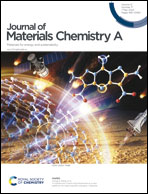Elucidating the degradation mechanisms of Pt-free anode anion-exchange membrane fuel cells after durability testing†
Abstract
The development of anion-exchange membrane fuel cells (AEMFCs) has recently accelerated due to synergistic improvements yielding highly conductive membranes, stable ionomers, and enhanced alkaline electrocatalysts. However, cell durability, especially under realistic conditions, still poses a major challenge. Herein, we employ low-loadings of Pt-free Pd-based catalysts in the anode of AEMFCs and elucidate potential degradation mechanisms impacting long-term performance under conditions analogous to the real-world (high current density, H2–air (albeit CO2-free), and intermittent operation). Our high-performing AEMFCs achieve impressive performance with power densities approaching 1 W cm−2 and current densities up to 3.5 A cm−2. Over a 200 h period of continuous operation in H2–air at a current density of 600 mA cm−2, our model Pd/C–CeO2 anode cell exhibits record stability (∼30 μV h−1 degradation) compared to the literature and up to 6× better stability than our Pd/C and commercial Pt/C anode cells. Following an 8 h shutdown, the Pd/C–CeO2 anode cell was restarted and continued for an additional 300 h with a higher degradation rate of ∼600 μV h−1. Thorough in situ evaluations and post-stability analyses provide insights into potential degradation mechanisms to be expected during extended operation under more realistic conditions and provide mitigation strategies to enable the widespread development of highly durable AEMFCs.



 Please wait while we load your content...
Please wait while we load your content...